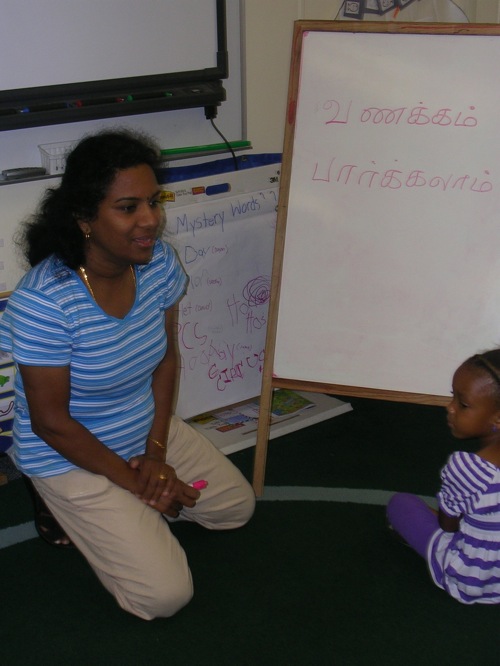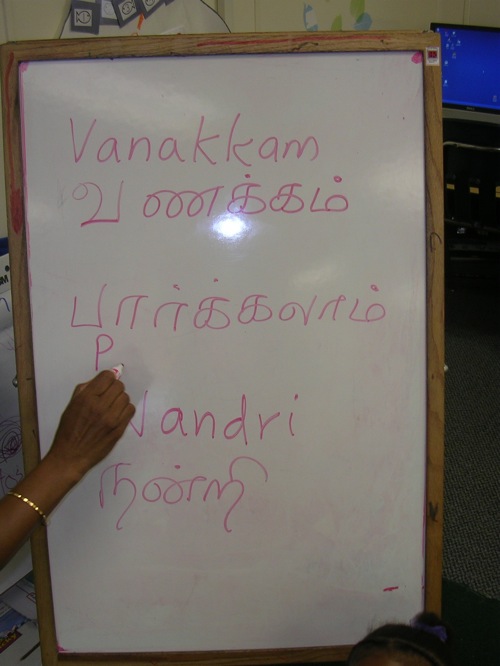Creating a School Culture of Respect and Appreciation
by Sabina Mosso-Taylor
The Spears Creek Road Child Development Program is located in Columbia, South Carolina. The program serves 260 three-, four, and five-year-old children in thirteen classrooms scattered throughout the district in nine elementary schools. Five of the thirteen classrooms operate as a Montessori Magnet within the Spears Creek Child Development Program. One teacher and two assistants, one-full time and one part-time, work with twenty students in each classroom. We are a tuition-based program for three- and four-year-olds, but accept vouchers for families who qualify. There is no charge for kindergarten students, providing socioeconomic diversity.
Our Program Philosophy and Faculty
We respect each and every child as a unique and dynamic being; therefore, to best meet the needs of our children, variety, quality, and relevance are the cornerstones of our program. Cognizant that all aspects of development are interwoven, the learning environment is designed to foster and sustain intellectual, social, personal, emotional, physical and creative growth simultaneously. To promote such growth, we strive to maintain a program that is child-centered and experienced-based. We believe that teachers serve as guides and facilitators of learning and provide essential sensory, perceptual motor experiences for each individual child.
Our conviction is that a comprehensive, sound early childhood curriculum enables each child to:
- •Continue to foster a positive literate identity.
- •Grow in ability to relate, interact, and communicate effectively with peers and adults.
- •Acquire the attitudes, knowledge, and skills necessary for critical thinking, creative expression, and productivity in an ever changing world.
We respect the role and the rights of parents and families in their children’s learning, and seek a cooperative home-school relationship. We endeavor to create and sustain an atmosphere of welcome to encourage families to contribute to and to benefit from our program.
All teachers are certified in early childhood education and have the minimum of a Bachelor’s degree in early childhood. Many hold Master’s degrees and some have National Board Certification. Our faculty is fairly homogeneous – one female teacher is a person of color, one is a White male, and all others are White female teachers. Our students, on the other hand, are very diverse. Approximately 59% of students are children of color. Our teaching assistants are also diverse and are a valuable part of our program.
A Glimpse into Our School
As the lead teacher of the Spears Creek Road Child Development program I often visit classrooms and spend time with the students getting to know a little bit about them, who they are and what they like, as much as possible with 260 students. Occasionally, I am asked to help out in the classrooms. One day as I assisted Mrs. Frierson, and her sensational class of three- , four- and five-year-olds, we decided to go outdoors to read since the weather was especially beautiful. The students asked me to read A Pocketful of Kisses by Audrey Penn (2004), the story is of a young raccoon, Chester, and his woodland friends. As I began reading, I came to a picture of a snake in the book, and Mason, one of the older students, shouted, “Hey, how do you say that in Spanish?” Knowing only a little Spanish, I said, “You know, I am not sure.” Mason immediately turned to Pedro, a bilingual Spanish/English student, and asked, “Pedro, how do you say snake in Spanish?” Without hesitation Pedro responded, “serpiente.” The students and I repeated the word, with Pedro taking the lead. As I read further, this interaction continued throughout the story. The students came across other animals, such as a mouse and rabbit, with Pedro providing the Spanish translations, “ratón” and “conejo.” Pedro and I took turns taking the lead, as the students looked to him for translations for the animal names as I read aloud from the book. Pedro never appeared to be surprised by the requests, always proudly offering translations.
Valuing All Literacies
This scenario is one small example of how children in our program value each others’ languages and cultures. As I later relayed this story to Pedro’s mom, we laughed as we reminisced about the once quiet little boy who entered school the previous year at three-years of age, not so interested in speaking Spanish at school. How he had grown! As the administrator of the program, I feel that these engagements are not only important, but our obligation to students and their families. Interactions such as these serve to create a culture of learning inclusive of all ways of knowing and being. This is particularly true for supporting children’s language learning in school. Our program consists of many students from bilingual homes, including Korean, Japanese, Tamil, Telegru, Spanish and Russian. Therefore, it is critically important that the teachers in our program value students’ home language in their classrooms while they simultaneously learn English or any other language (Nieto, 2008; Valdés, 2001).
Students also need to see, as much as possible, faculty and staff who are representative of their cultures and who, whenever possible, speak the students’ languages. We are fortunate to have wonderful assistants such as Señora Heron, who speaks predominately Spanish to the students and who helps to support the Spanish-speaking students in our program. She also serves as our Spanish teacher, teaching Spanish to each of the thirteen classrooms for 30 minutes a week. Another valuable teacher’s assistant is Mrs. Samanthapudi, who speaks Telegru. One of her students, Nidhi, is from India and speaks Telegru. Mrs. Samanthapudi converses with Nidhi at school and is able to greet and speak with her family in their native language.
Family and Community Support of Curriculum
Some parents in our program have come to their children’s classrooms to teach their home languages, such as Russian or Tamil, share interesting facts and stories, and teach students about the things that are important to their family. In these situations, teachers and students are learners, learning from and with families. Family knowledge is placed at the forefront of the curriculum in our school, providing opportunities for voices to be heard who may have been previously silenced, underrepresented, or misrepresented. Parents and teachers work together to ensure that children see themselves, their families, and their community represented in the curriculum and materials in the classroom. For example, family pictures adorn the classroom shelves, book cases, and walls; language and literature in students’ native languages are available in reading and writing areas; and parents are encouraged to create labels for the room, read books on tape for the listening center, and share printed material such as magazines and books for the reading center.
Students’ parents and family members are valuable resources for our school. Further examples are the exciting interactions happening particularly in Mrs. Frierson’s classroom. Dr. Julia López-Robertson, also known as, “Pedro’s mom,” visits the class once a week to read Spanish literature. She has Mrs. Frierson’s class enamored with Señor Calavera from the Yuyi Morales’ books. Julia is a professor at the University of South Carolina and serves in a community role as a University instructor. She teaches her language and literacy class on our school’s campus and her 25 students, or Amiguitos, engage in one-on-one interactions with the students in our program. This partnership further serves to support our students’ literate identities.
Our Role as Educators and Leader
Understanding our role as educators in the support of students’ identity development is of particular interest to me as an administrator and is one that we all take seriously in our program. For that reason, professional development is a key to staying abreast of the literature and research in the areas of diversity, language marginalization, and identity development. As Neito and Bode (2008) suggest, teaching students about diversity has to be more than teaching about piñatas and tacos; there has to be a sincere commitment from all involved to provide all students with a more inclusive understanding of the world around them. All too often, teachers are left alone to create this kind of environment for students, or fight an uphill battle with administrators who may not share the same sense of urgency. Our program differs in that the school culture is created and sustained by the administrator, faculty, staff and parents who believe that these interactions between and among students, families, teachers and administrators are not only valued but must exist for everyone to truly learn.
Conclusion
I am in awe and thankful for our richly diverse students and their families, because they enrich our program and our lives in so many ways. I appreciate and respect my faculty and staff for seeing the need to go beyond what has been traditionally valued in schools to embrace all ways of knowing, including the various languages and literacies in our students’ worlds, and to further explore their own biases and stereotypes as they seek to understand others. Although we are far from perfect, we are constantly striving to work to be better for our students and their families. Through parent, family and community involvement and teachers’ continued actions in supporting students and their families in their classrooms, I have renewed confidence in myself as a leader, that together we can make our program one that we – students, families, faculty and staff- can be proud of. A place where all can proclaim-This is OUR school!
References
Morales, Y. (2008). Just in case: A trickster tale and Spanish alphabet book. New York:: Roaring Book.
Neito, S.and Bode, P (2008). Affirming diversity: The sociopolitical context of multicultural education. Boston, MA: Pearson.
Penn. A. (2004). A pocketful of kisses. Washington, D.C.: Child Family Press
Valdés, G. (2001). Learning and not learning English: Latino students in American schools. New York: Teachers College Press.
Sabina Mosso-Taylor is currently the Lead Teacher of the Spears Creek Road CD and Montessori program in Richland School District Two. She is also a doctoral candidate in Early Childhood Education at the University of South Carolina.
WOW Stories, Volume III, Issue 1 by Worlds of Words is licensed under a Creative Commons Attribution-NonCommercial-ShareAlike 4.0 International License.
Based on a work at https://wowlit.org/on-line-publications/stories/storiesiii1/.



One thought on “WOW Stories: Connections from the Classroom”
Comments are closed.